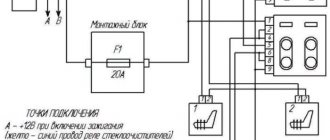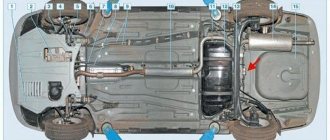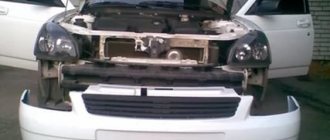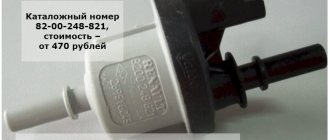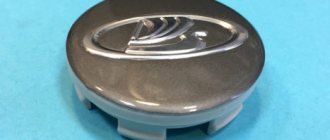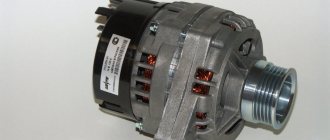Engine: VAZ brand, made in Russia
Under the hood of the Lada Vesta there is a 1.6-liter 16-valve naturally aspirated 4-cylinder engine. Power - 106 hp. With. at 5800 rpm, torque - 148 Nm at 4200 rpm. Compliance with Euro-5 standards. The engine received the marking 21129, although the designation 21126 is clearly visible on the block itself. There is no need to be surprised, since all modifications of the engine (126/127/129), which trace its history back to Priora, have a single block.
Features: original suspension system and attachments; the intake and exhaust system has been changed; adaptation for the installation of a Renault gearbox, as well as about 20 other innovations, including a lightweight connecting rod and piston group made in Tolyatti by Federal Mogul.
A test drive of Vesta showed that the engine has very good output and elasticity, but is a little noisy at high speeds.
The engine fits right into the engine compartment of the Vesta. Access to all attachments is extremely limited. The entire engine is literally shrouded in wires - during the disassembly process I had to disconnect about 40 connectors and, with some difficulty, pick out a whole bag of fasteners.
The oil filter (Avtoagregat, Russia) is sandwiched between the subframe and the exhaust manifold, and it is not protected from the latter by any heat shield, which raises some concerns. The drive belt and its tension pulley practically rest against the inside of the body, just like the timing mechanism, so replacing them is only possible with a complete disassembly of the front right side of the car, dismantling the right additional side member and hanging the engine.
The officials confirmed to us other information that we suspected, but did not check ourselves. Due to the fastening features, removal of the engine sump (crankcase) is only possible with the removal of the gearbox.
DIY Vesta air intake mesh
- 340 rub.
- Description
- Reviews (8)
- Question answer
Interior air intake mesh with magnets for Lada Vesta car.
The mesh covers the inlet to the car's air intake, creating an obstacle for various small debris; the dust itself is already filtered by your cabin filter.
The mesh is installed in a regular place without drilling the body, fixed with neodymium magnets (supplied with the mesh)
1. Remove the windshield wiper arms 2. Remove the plastic frill (6 torx t20 screws) 3. Install the mesh 4. Fix it in the hole with magnets 5. Reassemble in reverse order
Gearbox: Renault brand, made in Russia
The Lada Vesta is equipped with a French 5-speed manual transmission JH3-510. The transmission housing is cast at VAZ's own metallurgy. Actually, all assembly is carried out in Tolyatti.
The choice in favor of a foreign gearbox was made due to the fact that in the native VAZ engineers were unable to overcome extraneous noise, in particular the hum of gears. It is known that the French gearbox costs AvtoVAZ 20% more than the domestic one.
Let us recall that the AMT “robot” was created on the basis of a domestic gearbox, in which the problem of noise (in particular, a muffled howl in second gear) is still relevant. We have no complaints about the performance characteristics of a manual transmission.
Cold intake from Vesta Sport
Lada Vesta SW Cross 1.8 5MT Luxe Multimedia Mars
Lada Vesta SW Cross 1.8 5MT Luxe Multimedia Mars
I feel like the jerking has disappeared in 1.2 gear. The car became more responsive when you press the gas pedal. There is always enough air now. In terms of the temperature of the incoming air, there is no change on the highway; in the city it may be a little hotter, but the difference is not so obvious. Because The entire intake system also got hot before. After 3t. rpm there was a roar like a sports car.
Work: I only pulled out the original box with the filter, unscrewed the adapter from it (with 2 bolts), which is then inserted into the rubber corrugation. This adapter was screwed directly to the Ford filter (all seats fit perfectly) and back into the corrugation to the throttle. Place the corner in the standard filter mounting location.
Radiators (cooling, heating, air conditioning systems): Valeo brand, made in Russia
All three Vesta radiators from the French brand Valeo (a well-known component manufacturer) are distinguished by good workmanship, in no way inferior to their world analogues. During dismantling, it was difficult to suspect that the radiators were assembled in Tolyatti at Valeo’s own production site.
By the way, the competence of the employees of the hotline of the Russian representative office of Valeo (where we were transferred to answer questions) was called into question. They couldn’t say exactly what was being assembled at the Valeo site in Nizhny Novgorod, and when asked about production in Togliatti, we were told that there was no confidence that it was working at all, although the press service of AvtoVAZ firmly confirmed the opposite.
Installing the rear window frill on the Lada Vesta
Anti-corrosion treatment of the machine The quality of the paint and varnish coating is also at the highest level. Amateurs and automobile experts checked whether the Lada Vesta's paintwork was reliable. No imperfections, scuffs or various coating defects, which often happened on previous models, were noticed.
Although the small thickness of the Lada Vesta LPC may raise doubts. But this trend is characteristic of many modern cars - environmental standards impose restrictions on the depth of the paint and varnish layer. High-quality soil protects the iron well, and corrosion is unlikely to spread due to ordinary chips.
The bottom, sills and arches have been additionally treated with a layer of anti-gravel. In total, the thickness of the body metal is about 0.7 mm.
Is additional anti-corrosion treatment required for the Lada Vesta body?
Body of the Lada Vesta AvtoVAZ really kept its promise and improved the quality of the body, and even gives a six-year warranty on it instead of the originally promised five-year. This is still not much when compared with market leaders, but still better than nothing.
Galvanized or not? Yes, galvanization is present. True, the cold method is not the most reliable - the body is processed only from the outside, with the exception of the floor screen, which is protected on both sides. The peculiarity is that not liquid, but powdered zinc is used - this way all the cracks and bends will be filled more efficiently.
The thickness of the zinc layer does not exceed 8 microns - this became the determining factor in calculating the warranty period.
In terms of corrosion protection, the main focus is on cataphoretic priming, one of the tasks of which is to protect the zinc layer. The process involves immersing the body in a cataphoresis bath. The anode is connected to the body, and the cathode is connected to the bath. Thus, positively charged soil will settle on the negatively charged metal, and the body will be completely covered with a film that has sufficient rigidity for full protection.
But it is worth remembering that the service life of the body depends not only on the quality of galvanization and paintwork, but also on the owner’s attitude towards his car. If you neglect regular washing and do not get rid of paintwork damage in a timely manner, the car may soon rust and in this case additional anti-corrosion treatment is necessary.
Expectations from Lada Vesta
Domestic cars had an eternal problem in the form of weak paintwork and the rapid formation of corrosion. Remember the same Priora, which within a year could acquire rusty areas, which is simply unacceptable for a modern car.
With the first announcements, it became clear that the Lada Vesta will be a car of a new level. Car owners shared their assumptions about what kind of body the Lada Vesta has and that it will finally have normal corrosion protection. Representatives of the plant assured the public that in this regard their new product would not disappoint anyone and even promised to provide a guarantee on the body.
Separate accessory
For the most part, the product is a reincarnation of the original side rubber bands that AvtoVAZ installed for some time, and then abandoned them and removed these seals from sale. This option is made of plastic.
Price about 650 rubles
Buy: at Vesta Shop.
Attention! Check out the photographs with captions to determine which frill you need (Short or Standard). Includes 2 side frills
- Side frills Standard come on all new Vestas with the hood seal wrapped in a ring (except when short hood stops are installed);
- The shortened version is suitable for older cars that have a plastic straight corner sticking out (see photo), and also if you installed short, rather than long, stops that are attached to the area in front of this square.
- Unscrew the 3 Torx screws.
- Unscrew 1 large wing screw with washer.
- Wind up the frill and secure it.
- If desired, glue it with tape (the tape is applied in reserve, the frill will stick like that, but we do not recommend removing it so that the plastic does not rub the paint).
- Screw the screws back.
Problem
The main problem associated with this body layout surfaces in the fall, when leaves begin to crowd into the wide opening. It is quite difficult to clean them out, and few people would want to constantly fish out fallen leaves from the opening.
But in winter the situation gets worse, as snow gets into the opening, which prevents the trunk lid from opening normally. But that's not all. Over time, if there is a thaw, it snows and rains, or the car occasionally drives into a heated parking lot, the snow in the opening melts and turns into ice. And this is a direct threat to Vesta’s paintwork. When opening the trunk, the ice simply peels off the paint from the edge of the trunk lid - in this case, all that remains is to repaint the part.
Without a frill, snow quickly accumulates in the opening.
Solution
As it turns out, it's quite simple. Manufacturers of accessories for the Russian sedan began producing rear window frills for the Lada Vesta. The frill is a plastic trim of a special configuration, which is inserted with one edge into the opening of the trunk lid (near the seal), while the other is placed on the glass.
As a result, the opening closes, and Vesta owners can safely drive without fear for the safety and appearance of their car. In addition, cleaning your car with a brush becomes noticeably easier, more convenient and faster.
This pad is made of durable ABS plastic, which is resistant to external influences. The color of the product is black, and light shagreen is visible on the surface.
Video review of frill for Vesta
Why is galvanization needed and what is it?
Paintwork is not enough to protect the body. The slightest damage and moisture does its job, causing oxidation of the steel. The corrosion center, unnoticeable at first, grows, and the car has to be repaired.
One of the most effective ways to prevent rust formation is galvanizing the body. Auto industry leaders have been practicing this procedure for many years. Thanks to this, they can provide a warranty on the body for up to 20 years.
The body can be galvanized in the following ways:
- heat treatment;
- galvanic treatment;
- cold processing.
With the cold method, the body is simply treated with a zinc-containing primer. In this case, manufacturers do not provide a long-term guarantee, because the protective layer may be damaged along with the paint.
Generator: Valeo brand, made in Türkiye
The generator of the same French brand Valeo, but already made in Turkey, confused us at first - instead of the usual orange transformer varnish, the windings are covered with protection that is not uniform in color. However, as they say, “the speed should not be affected.” But we consider the fact that the terminals from the winding were not soldered, but simply crimped, to be a disadvantage. Not durable.
In addition, dismantling the component (replacement) is extremely difficult due to its location. The generator is clamped by the air conditioning compressor from below and its tubes - from the end and from the top, and from the belt drive side, as well as the tension roller, by the wall of the engine compartment. As a result, when replacing the generator, you will have to remove the air conditioning compressor (if there is one, of course).
Three more Valeo components found: starter (Poland), release bearing and climate control unit (Czech Republic). The French company is one of the world's main manufacturers and suppliers of components for car factories, including, of course, fellow countrymen from Renault, from whom it migrated to AvtoVAZ.
Solution
As it turns out, it's quite simple. Manufacturers of accessories for the Russian sedan began producing rear window frills for the Lada Vesta. The frill is a plastic trim of a special configuration, which is inserted with one edge into the opening of the trunk lid (near the seal), while the other is placed on the glass.
As a result, the opening closes, and Vesta owners can safely drive without fear for the safety and appearance of their car. In addition, cleaning your car with a brush becomes noticeably easier, more convenient and faster.
This pad is made of durable ABS plastic, which is resistant to external influences. The color of the product is black, and light shagreen is visible on the surface.
Video review of frill for Vesta
Fuse box and its housing: Renault brand, made in Romania
The fuse box comes entirely from the Logan model, as evidenced by the Renault logos on the body and the Romanian manufacturer Capirom. True, AvtoVAZ reported that in the near future the company will change its supplier to a local one - from the Samara region.
We had no questions about the unit itself, but in the process of a scrupulous study by the electricians, a very interesting point emerged. Attention was drawn to two fuses that were not indicated either on the diagram or in the instructions. A study of the electrical circuit revealed that during a sudden voltage surge (for example, when lighting up a Vesta with the engine running), these fuses may burn out, resulting in the battery stopping charging. And what’s most insidious is that the driver of a discharged car will not know about it - no electrical “paths” to the dashboard (indicator lamps) could be found. Whether the reason will be revealed when connecting the standard diagnostic system in the absence of an error that pops up is also a question.
The controls also turned out to be imported - the steering rack is from the famous German brand ZF, but made in Malaysia. And the CV joints are provided by the British company GKN and made in Poland.
Why is galvanization needed and what is it?
Paintwork is not enough to protect the body. The slightest damage and moisture does its job, causing oxidation of the steel. The corrosion center, unnoticeable at first, grows, and the car has to be repaired.
One of the most effective ways to prevent rust formation is galvanizing the body. Auto industry leaders have been practicing this procedure for many years. Thanks to this, they can provide a warranty on the body for up to 20 years.
The body can be galvanized in the following ways:
- heat treatment;
- galvanic treatment;
- cold processing.
With the cold method, the body is simply treated with a zinc-containing primer. In this case, manufacturers do not provide a long-term guarantee, because the protective layer may be damaged along with the paint.
Brakes: TRW brand, made in the Czech Republic, Poland, Italy, France, Turkey
In order for the Lada Vesta to stop properly, manufacturers from almost half of Europe had to work hard. In total, we counted five countries producing the braking system, including French SNR bearings pressed into the rear brake drums (integrated with the hub) of the German ATE brand, but of Italian production. When it is necessary to replace the bearing, it will be extremely difficult to remove it separately - most likely, you will have to change the entire assembly. Although the name of the SNR brand, which is premium by the standards of the world of auto components, inspires hope for durability.
So, the brake master cylinder and vacuum booster came from Poland, the front calipers and pads came from the Czech Republic. Some of the brake hoses turned out to be made in Turkey by Teklas. One of the features is that there is one brake system reservoir for two with a clutch drive.
The only question regarding the brakes arose when considering the front pads, on which there was a working mark of the cylinder - a quarter of the pressing surface extends beyond the pads. It is difficult to say whether this somehow affects the braking efficiency. While driving, we had no complaints about the braking system.
You will also have to tinker with the suspension elements during repairs. According to “foreign” patterns, the ball (produced by the BelMag Magnitogorsk plant) comes assembled with a lever. Moreover, replacing a component will require a lot of additional actions to free up space around it. By the way, according to servicemen, play of ball joints and knocking of stabilizer struts are the most frequent complaints from the first owners of Vesta.
Shock absorbers are one of the few Vesta components on which we did not see the “Aglitsky language”. The racks were produced at the Skopinsky Automotive Assembly Plant in the Ryazan region. By the way, in terms of the balance of suspension characteristics, we recognize Vesta as one of the best in the class.
We saw the only “Made in China” inscription on the windshield wiper motor from Bosch, with the logos of another automaker - the Chinese company Chery
Various plastic parts
There is already such a diversity of companies and manufacturing countries that it makes no sense to single out anyone separately, so we’ll just list them.
The air filter and its housing turned out to be from the famous German brand Mann+Hummel, and of original production. The electric fuel pump module assembly (with an Arsan pump) is Russian. The radiator expansion tank hose is from Teklas, but not from Turkey, but from Bulgaria. Washer reservoir with Renault logos, Continental washer pump, made in the Czech Republic.
With the exception of the aforementioned Czech microclimate control unit, the plastic interior parts turned out to be Russian, in particular Izhevsk. Moreover, the quality of fastening (hence the country of production) of individual small parts could be determined by touch - they were either loose or fell out at the slightest touch.
There was also a Russian approach: the plastic frame of the gear lever (Italian-Russian company AE2) that was not “shrunken” was sharpened on the inside (apparently with a file) along the edge. The side plug of the front panel (on the side of the front right door) bounced off like a spring at the first attempt to snap it off (what voltage was it installed under?).
Taking into account some other flaws in the interior assembly in the form of naked screws and gaps, it is worth saying that the interior of the Lada Vesta is generally better assembled than can be expected from most modern Ladas, but it is felt that over time, part of it will traditionally “come to life”. By the way, at first glance we liked the interior assembly of the almost entirely imported Lada XRAY more.
Some time ago, the Avtostat agency published the full list of component suppliers - there are also a dozen foreign brands that we have not mentioned. Some of them, by the way, did not coincide with the real ones - in particular, the tires on our Vesta were Pirelli, not Continental.
Problem
The main problem associated with this body layout surfaces in the fall, when leaves begin to crowd into the wide opening. It is quite difficult to clean them out, and few people would want to constantly fish out fallen leaves from the opening.
But in winter the situation gets worse, as snow gets into the opening, which prevents the trunk lid from opening normally. But that's not all. Over time, if there is a thaw, it snows and rains, or the car occasionally drives into a heated parking lot, the snow in the opening melts and turns into ice. And this is a direct threat to Vesta’s paintwork. When opening the trunk, the ice simply peels off the paint from the edge of the trunk lid - in this case, all that remains is to repaint the part.
Without a frill, snow quickly accumulates in the opening.
How the body is made
Let's admit: the Lada Vesta, which is attractive in our opinion, is very well assembled in terms of its bodywork. The measured gaps are everywhere at the level of a couple of millimeters. Well, the softness and silence with which the doors close are completely worthy of applause. And everything would be absolutely wonderful if we had not started studying the car from below.
In general, of course, there is no “crime”. The first thing that caught my eye was the sloppiness of the anti-corrosion treatment, in the category of “we’ll apply it here, but it’ll do just fine.” It can be seen that some areas were treated over the protective film, which was then torn off along with the protection. Moreover, in the same place it was done with completely different quality (carefully and clumsily).
An incident was discovered under the hood - at the factory, a piece of paper was attached to one of the side members with tape, apparently with an example of a color called “platinum”, in which it was necessary to paint the car from the inside. Actually, they painted this piece of paper, forgetting to tear it off - naturally, there was a stripe under it without painting.
The rear beam mounts, apparently, are not original. One of the “ears” for the bolts was left protruding into the wheel arch.
Another point is the accuracy of internal bends and connections of individual body parts. Between some of them there are considerable technological holes into which, of course, dirt, salt and road chemicals will get clogged. Considering that some of these connections have not been exposed to anticorrosive agents, they are likely to become centers of corrosion, especially in the wheel arches.
For the purity of the experiment, we looked under the bottom of the first Vesta competitor we came across - the Skoda Rapid liftback (in the database from 539,000 rubles). It has an armor-piercing shield underneath, wrapped in treatment without a single crack or stain, and even with two plastic sheets of protection on top.
Life hack: installing front and rear frills on a Lada Vesta car, main faults
The frill on the Lada Vesta car is located at the front and rear. This is a kind of protection from debris and precipitation, in addition to the fact that the frill covers the cracks of the rear window and rear trunk. For the Lada Vesta car, for additional protection, a mesh is also installed on the frill. Read the article to the end and we will cover this topic. The car body must be moderately sealed, protecting internal components and assemblies, the driver, passengers, and their luggage from bad weather, dirt, and debris. If the comfort of the driver and passengers is maintained, raindrops do not fall on them, and the temperature regime is set thanks to the stove with air conditioning.
In this case, it is worth paying tribute to the door seals, which do not allow moisture to pass through, moving it down through small grooves. The engine and trunk also have their own covers that protect everything inside from water and debris. The frill on the Lada Vesta under the hood protects the space from dust, dirt, leaves, and moisture.
At any time of the year, it is better to leave the engine compartment dry and clean - this way you will extend the life of your car. In addition, the moisture accumulated in the recess will begin to “fight” the paintwork, and leaves and dirt will try to interfere with the operation of the air filter. The frill on the rear window of a Vesta car closes the large gap between it and the trunk lid, leaving “paths” for moisture to drain from the car without getting inside.
Factory frill - article number and price
At the rear, the manufacturer only installed a seal under the trunk lid. Catalog number – 845-000-7607 (can go under article number 845-003-0929). Cost – 1250 rubles. The windshield protection with the engine compartment consists of several parts.
Front
Purchased rear frill
The trunk is poorly protected; instead of a thick seal from the factory, there is just a gap in which water accumulates, and when opened, it drains down into the trunk. Enthusiasts took on the development of a rear window accessory for Lada Vesta. Their task was to create a seal that could reduce the gap by creating a groove through which moisture would flow.
The result was a project for tuning the rear window. Several models are in the public domain, almost in mass production. One of these accessories is even installed and held in place without adhesive tape, which is undoubtedly a plus - it’s more reliable without it.
Basic faults
Since the main damage to a car without a good seal is caused by snow, leaves, ice, water, dust, and any dirt. Water, clogging into the cracks, can remain there for a long time, which will accelerate the appearance of “saffron milk caps” on the body – on the trunk lid.
Foliage that gets into the space between the hood and windshield interferes with air exchange.
Manufacturers and prices of analogues
- A wonderful invention for Vesta - a jabot made from adhesive tape from Yuago - costs only 1,250 rubles. The cover is made of ABS plastic and protects the rear window opening, while creating a drain for water to move downwards.
- There is a simpler analogue, which is sold under the article number VS-GRD-ZS. Its cost is just over 600 rubles. At first, car enthusiasts glued it with double-sided tape, and then with sealant. In addition, the color is lighter and rather gray, unlike the Yuago version.
Installation of front and rear frill
This operation does not require a visit to the dealer at all. But the installation of the upper seal of the windshield is carried out together with the glass itself in order to maintain the tightness and strength of the installation. The frill mesh on the Lada Vesta is installed independently - just lift the hood, place the trim first vertically, and then deepen it into the hole under the windshield, tilting it slightly away from you, applying it to the glass itself.
For the rear window, the priority is to work with the trim without tape. Open the trunk, pull the trim back behind the lid so that it is under the levers. Remove the rubber seal, install the seal - it is made exactly to the size of the trunk. Put the seal back.
If you are going to install a more economical option, first apply sealant to the part that will be in contact with the body - the rest will engage with the glass due to its shape.

